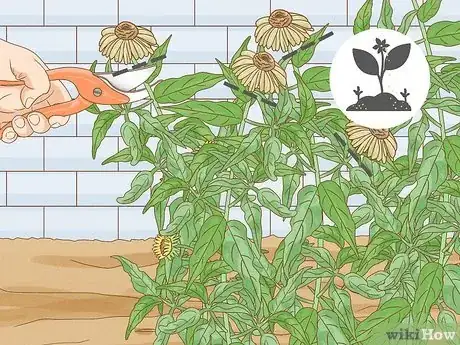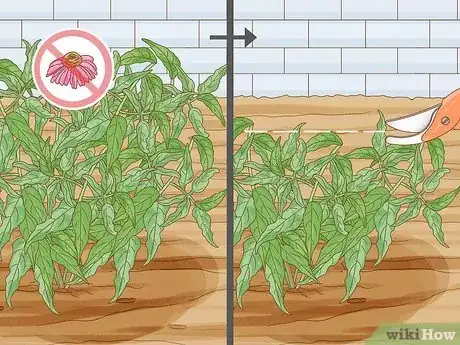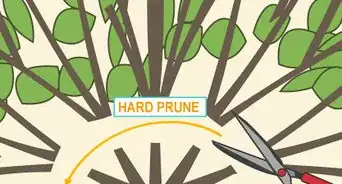This article was co-authored by Matt Bowman and by wikiHow staff writer, Aly Rusciano. Matt Bowman is a Gardener, Landscaper, the Owner of Georgia Farm to Table, and the Owner of Tradition Property Services in Atlanta, Georgia. With over 20 years experience, he specializes in organic gardening, landscape maintenance, handyman services, homecare services, and supplying Christmas trees. Matt earned a BA in Journalism from the University of Georgia.
There are 7 references cited in this article, which can be found at the bottom of the page.
This article has been viewed 58,315 times.
Coneflowers or echinacea can be a wonderful addition to any garden or yard. With growing coneflowers being relatively simple and their care being low-maintenance, you may be wondering, “What about pruning?” Luckily for you, coneflowers are low-maintenance and don’t necessarily require any pruning. However, you can use a few simple pruning techniques to enhance its beauty, manage its slow but steady growth, and extend the plant’s blooming season.
Steps
Deadheading Spent Flowers
-
1Cut fading flowers and their stems down to encourage future growth. Once a coneflower plant turns brown, the flower will quickly shrivel up and die.[1] At this point, you can use pruning shears to cut off the spent flower and its stem (called “deadheading”). Trace down the spent flower’s stem until you reach the next lateral stem with a blooming flower or bud, and then cut the stem just above the joint.
- The best time of year for deadheading will vary based on the coneflower blooming season where you live. That said, you should plan to start deadheading about 2 weeks after the first blooms appear and continue throughout the blooming season.
-
2Deadhead coneflowers to limit self-seeding. Once a flower fades, the coneflower plant expends energy-producing seeds that will eventually fall from the spent flower and sprout new coneflowers in the same area. Cutting coneflowers once they’re shriveled reduces the energy spent on seed production, which may result in more blooms in the future that are longer-lasting and brighter.
- Deadheading also reduces the number of seeds falling to the ground, which can help keep your coneflowers from claiming more garden territory.
Advertisement -
3Skip deadheading coneflowers to let the flower spread naturally. If you don’t mind how the coneflower section of your garden spreads, let the wilted flower and seeds fall where they are. This will give you a natural flower meadow look and invite birds to your yard.
- Each year you leave the coneflowers alone, their area will grow larger.
- After 3 to 4 years, you may be ready to divide your coneflower plants and replant some of them elsewhere.
- Finches and many other types of birds love coneflower seeds, so don’t deadhead if you want lots of feathered friends to visit your garden!
Cutting Back Plants Annually
-
1Use pruning shears or hedge clippers to cut coneflower plants to ground level. You don’t have to get fancy here—simply place your shears or clippers as close to the ground as you can and cut down as many stems as you like (or all of them). Pruning shears will work in any instance, but hedge clippers might make the job quicker if you have a lot of coneflowers to prune.
-
2Cut coneflowers down in the fall as an aesthetic choice. Each fall, your coneflower plants will die off, leaving behind brown stems and wilted flowers. Some gardeners prefer pruning the flower at this stage to keep their yard looking well-groomed.[2]
- Coneflowers will rebloom in the spring whether or not you cut away the dead plant material.
-
3Prune coneflowers in late fall or early spring based on preference. The coneflower plant doesn’t care whether you prune it to the ground or not, and it also doesn’t mind whether you prune it down right after a growing season or right before the next one. The choice is up to you.
- You may decide that pruning in the fall makes your garden look better, and it might also reduce the number of seeds that make it to the ground (and thus limit coneflower expansion).[3]
- Or, if you’d like to provide your local birds with some yummy seeds before winter comes, you can wait until the next spring (before any signs of life return to the plant) to chop it down.[4]
Pruning to Extend Blooming Season
-
1Wait to prune coneflowers until buds are about to appear to promote growth. Coneflowers can bloom at different times based on your local climate and conditions. Look for a surge in growth in your coneflower patch, noticing any new buds. Then, cut away dried stems to make room for the new flowers to grow.[5]
- If you do this pruning technique too early—before any buds have appeared—it will make little or no impact on extending the blooming season of your coneflowers.
- If you do it too late—once numerous buds have appeared—you’ll simply be chopping off flowers shortly before they open up.
- Consult other local gardeners and/or farmers to see when they prune their coneflowers.
-
2Cut down half of the coneflower plant’s main stems to extend blooms. For instance, if you have a 2 ft (61 cm) circle of coneflowers growing against a fence, divide the circle in half, parallel to the fence. If all the stems are roughly 2 ft (61 cm) high, cut those in the front half of the circle down to about 16 inches (41 cm) high with pruning shears.[6] [7]
- Cut each main stem just above the lateral stem to help produce a flower bud faster.
- If you want to be a bit more aggressive in your attempt to extend your blooming season, divide the coneflower stems into 3 sections, then prune down 1 section by a third and another in half.
-
3Deadhead the un-pruned coneflower stems once they start blooming. The stems you didn’t prune down will probably begin to bloom within a week or two. Once the flowers do start blooming, check daily for spent flowers and deadhead them—that is, cut the flower and stem off just above the junction with the next lateral stem.[8]
- In this case, deadheading helps direct energy toward flower production in the stems you pruned down.
-
4Watch for the pruned half to bloom 2 to 3 weeks after the un-pruned half. Pruning essentially stunts coneflower growth, causing them to fall a few weeks behind their annual flowering process. This means that as the un-pruned half of your plant stops flowering for the season, the pruned half will keep producing beautiful flowers for a few weeks past its typical season.[9]
- For example, coneflowers will bloom for about 1 month in many locales. Therefore, this pruning process can potentially extend the blooming season from 1 to 2 months.
- Care for a blooming coneflower by watering it well and spraying for insects.
References
- ↑ https://youtu.be/cdqNE-lsjl8?t=36s
- ↑ https://ar.audubon.org/sites/default/files/static_pages/attachments/native_pruning_tips.pdf
- ↑ https://youtu.be/fCcXsMIZbTQ?t=40s
- ↑ https://youtu.be/fCcXsMIZbTQ?t=20s
- ↑ https://www.rhs.org.uk/plants/41568/echinacea-purpurea/details
- ↑ https://plantaddicts.com/pruning-deadheading-coneflowers/
- ↑ https://ar.audubon.org/sites/default/files/static_pages/attachments/native_pruning_tips.pdf
- ↑ https://naturework.com/garden-info/handouts/pinching-pruning-and-cutting-back-perennials/
- ↑ https://naturework.com/garden-info/handouts/pinching-pruning-and-cutting-back-perennials/




































































